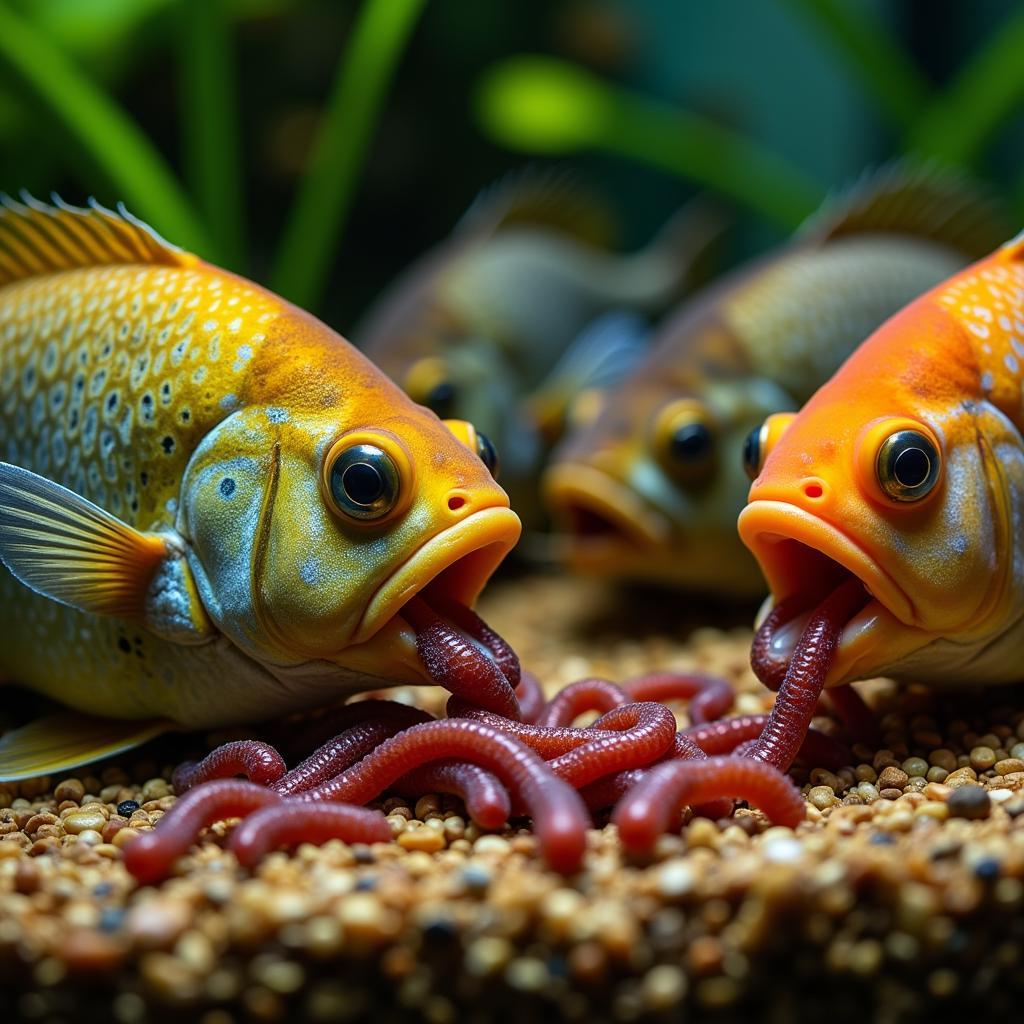Live Aquarium Food offers a natural and enriching diet for your aquatic pets. From the tiniest fry to the largest predatory fish, live food can enhance their health, color, and overall vitality. This guide delves into the world of live aquarium food, covering everything from its benefits to safe sourcing and proper culturing techniques.
The Benefits of Live Aquarium Food
Feeding your fish live food replicates their natural diet in the wild. This has several advantages. Live food is typically higher in protein and essential nutrients than processed foods, contributing to faster growth and stronger immune systems. The movement of live food also stimulates natural hunting instincts, providing mental and physical enrichment for your fish. Furthermore, live foods can enhance the vibrant colors of your fish, making them appear healthier and more attractive. Some fish, especially picky eaters or those recovering from illness, may only accept live food. For example, Betta fish thrive on a diet rich in live food, like bloodworms and daphnia. You can find more information on live food for Betta fish at live food betta fish.
Sourcing Live Aquarium Food Safely
When sourcing live aquarium food, safety is paramount. Purchasing from reputable suppliers is crucial to prevent the introduction of parasites or diseases into your tank. Look for suppliers who specialize in live food and have positive reviews from other aquarists. Avoid collecting live food from potentially contaminated sources like polluted ponds or streams. Quarantining newly acquired live food in a separate tank is another preventative measure to observe for any signs of illness before introducing them to your main aquarium. If you’re interested in live food options for your freshwater community tank, check out best fish food for community tank.
What are the different types of live aquarium food?
There’s a wide variety of live aquarium food available, catering to different fish species and dietary needs. Common options include brine shrimp, daphnia, bloodworms, micro worms, and vinegar eels. Each type has its own nutritional profile and is suitable for different sizes and types of fish. For instance, Bumblebee Catfish appreciate a varied diet including bloodworms. Learn more about their dietary needs at bumblebee catfish food.
Culturing Live Food at Home
Culturing live food at home can be a cost-effective and rewarding experience. It gives you complete control over the quality and safety of your fish’s food. While each type of live food has its specific culturing requirements, some general principles apply. You’ll need a suitable container, a culture medium, and a starter culture. Maintaining proper temperature, aeration, and lighting is crucial for successful culturing. Regular harvesting and feeding will ensure a continuous supply of fresh, nutritious food for your aquarium inhabitants.
Can I feed my Betta fish Tetra food as a supplement to live food?
Yes, Tetra food can be a good supplement, but shouldn’t be the main source of food. Discover more about incorporating Tetra food into a Betta’s diet at tetra food for betta.
Choosing the Right Live Food for Your Fish
Selecting the appropriate live food depends on the species, size, and dietary requirements of your fish. Smaller fish and fry typically require smaller live food like micro worms or newly hatched brine shrimp. Larger fish can be fed larger options like bloodworms or adult brine shrimp. Researching the natural diet of your fish species will provide valuable insights into their preferred live food choices. You can learn more about suitable live food for various freshwater fish at live food for freshwater fish.  Feeding Live Food to Aquarium Fish
Feeding Live Food to Aquarium Fish
Conclusion
Live aquarium food is a valuable addition to any aquarist’s toolkit. By providing a natural and enriching diet, live food can significantly improve the health, vitality, and vibrancy of your aquatic pets. From sourcing safely to culturing at home, understanding the nuances of live aquarium food empowers you to provide the best possible care for your fish.
FAQ
-
Where can I buy live aquarium food? Reputable aquarium stores and online retailers specializing in live food are good sources.
-
How often should I feed live food? This depends on the species and age of your fish. Start with small amounts and observe their eating habits.
-
Can I overfeed my fish with live food? Yes, overfeeding can lead to water quality issues. Only feed what your fish can consume in a few minutes.
-
Is it safe to collect live food from the wild? It’s generally not recommended due to the risk of introducing parasites and diseases.
-
How do I store live food? Storage methods vary depending on the type of live food. Consult specific guidelines for each type.
-
What are the signs of contaminated live food? Foul odor, unusual discoloration, and lethargic movement can indicate contamination.
-
Can I culture live food if I’m a beginner? Yes, some live foods like daphnia and brine shrimp are relatively easy to culture.
For any assistance, please contact us at Phone Number: 02437655121, Email: [email protected] or visit us at 3PGH+8R9, ĐT70A, thôn Trung, Bắc Từ Liêm, Hà Nội, Việt Nam. We have a 24/7 customer support team.